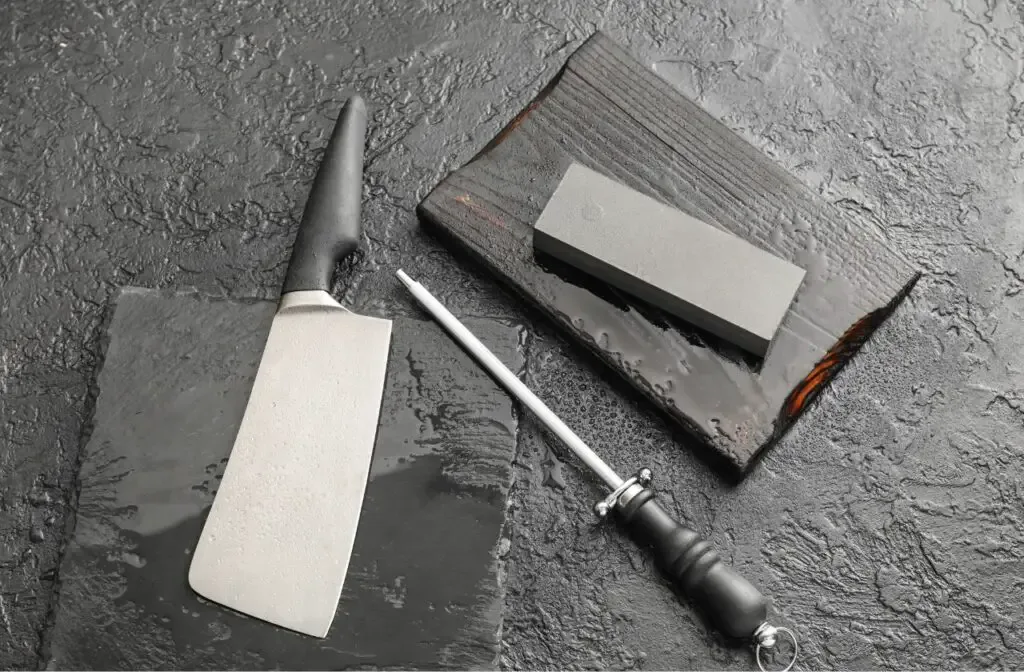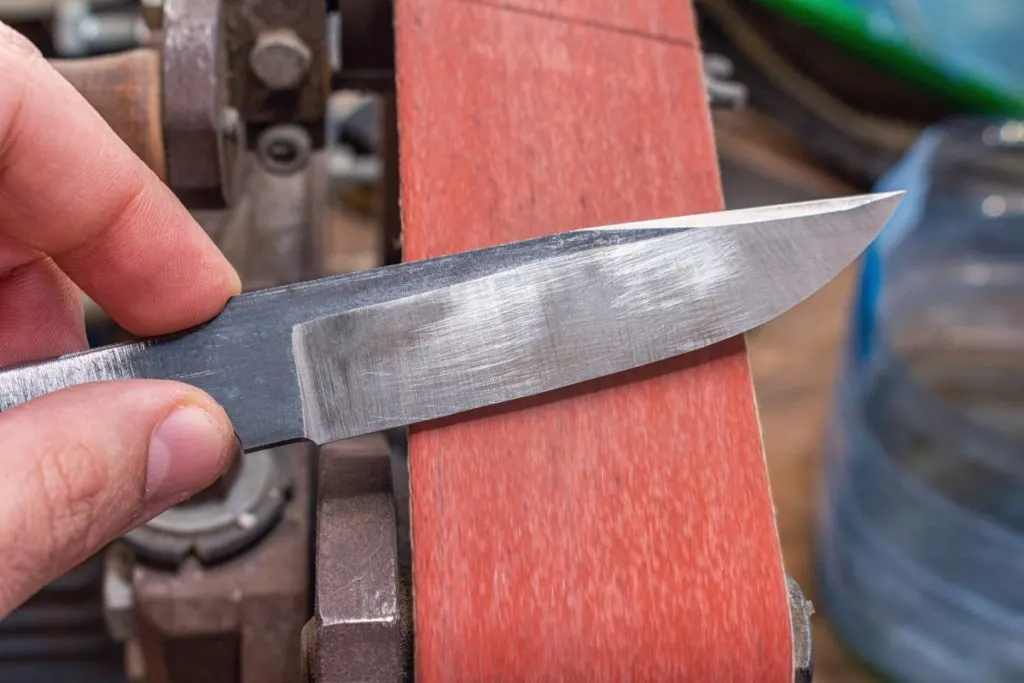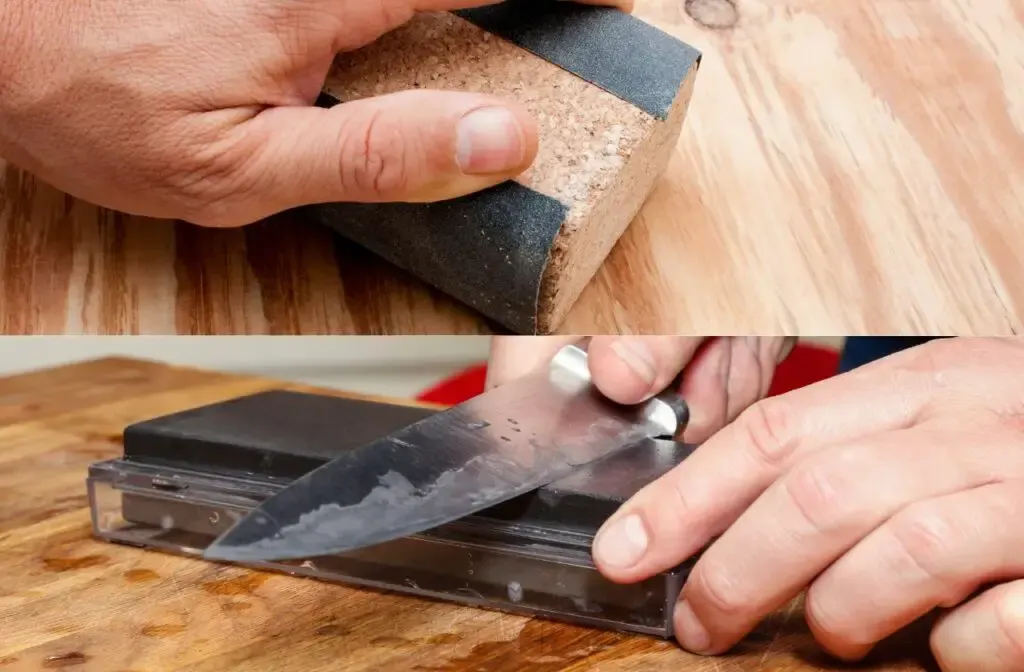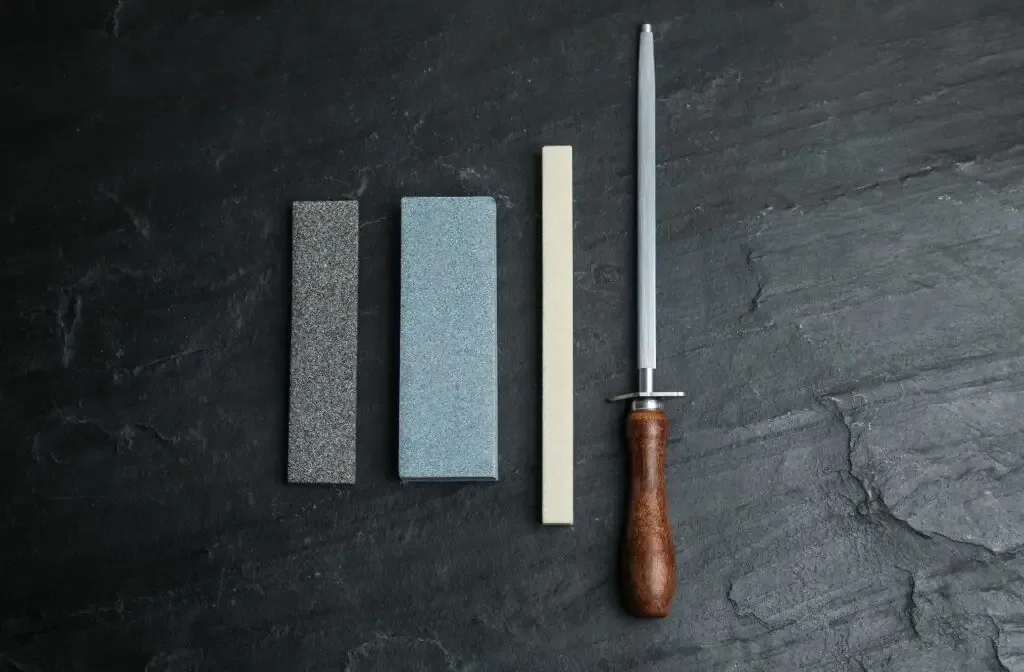As an Amazon Associate, we earn from qualifying purchases with no additional costs for you.
Whetstones are considered the premium knife sharpening tools to create an edge that is difficult to match with other sharpening methods. Whetstones start at a low, coarse grit and become progressively fine with higher grits, giving control over the sharpening process. Sandpaper also provides these basic qualities, so can you use this medium as a suitable alternative?
Sandpaper can be used to sharpen knives as an alternative to whetstones. Sandpaper is cheaper and provides a good alternative to people learning the skill before investing in expensive stones. Whetstones are more durable than sandpaper and can last many years if well-maintained.
Knife sharpening essentially uses an abrasive to remove metal from a knife’s edge to produce a sharp edge. Whetstones and sandpaper have similar abrasive qualities, and both can be used to sharpen knives with good results. What differences would cause someone to opt for a whetstone over sandpaper for sharpening?
If you are interested in checking out the best whetstones for your knives we recommend and use, you can find them by clicking here (Amazon link).

What Does A Whetstone Do?
Whetstones are considered the ultimate knife sharpening tool if you want to get a great edge on your knives.
Whetstones consist of an abrasive material manufactured in a block format for sharpening knives, chisels, and other edged tools. The abrasive material can be aluminum oxide, silicon carbide, natural stone, ceramic, and industrial diamond chips.
The whetstones are made in different grit coarseness, starting at low grits to fix damaged edges to high grits to put a polished edge on the blade. Whetstones are hard and flat, providing an ideal surface for creating a sharp edge on a knife.
When the whetstones are used on a knife’s edge, the abrasiveness of the stone cuts small particles of steel away from the knife’s edge. By controlling the angle at which the knife meets the stone, a person can shave down the metal on the edge to produce an extremely sharp edge.
At low grit, whetstones will remove relatively large quantities of material from the steel but leave a coarse finish. Progressing up the whetstone grits, the edge can be honed smooth and finally polished in a finishing grit stone greater than 6000 grit.
This will put a mirror-like polish on the edge of the knife, creating a shaving-sharp edge!
TIP: Are you looking to buy a new whetstone? Check out our recommendations (we personally use the first three ones):
Our PRO choice whetstones combo (Amazon links):
- Fixing stone: Whetstone SHAPTON Ceramic KUROMAKU #320
- Sharpening stone: Suehiro CERAX soaking whetstone: Medium #1000
- Finishing stone: Whetstone SHAPTON Ceramic KUROMAKU #5000
Our budget choice (Amazon link): Sharp Pebble Extra Large Sharpening Stone Set
Can You Use Sandpaper As A Whetstone

Sandpaper is often manufactured with similar abrasives to that of some whetstones, which suggests that sandpaper can be used as a whetstone.
Silicone carbide and aluminum oxide sandpaper can be used to sharpen knives instead of whetstones. Wet and dry sandpaper with a hard backing will produce an edge comparable to that of a knife sharpened on a similar grit whetstone. This is a good option for beginners starting out knife sharpening.
Many people use sandpaper as an alternative to whetstones, and some use a combination of sandpaper and whetstones, which produces an excellent edge on the knife.
The sandpaper can be secured to a solid, flat surface such as a granite block, steel plate, or a flat piece of hardwood to act as backing for the sandpaper.
The blade can be sharpened in the same way as a whetstone by passing the knife’s blade over the sandpaper using the same action as you would with a whetstone.
Another technique is also possible with sandpaper as the sharpening medium. The knife is secured in place, and the sandpaper is passed back and forth over the edge at the correct angle to repair, hone, and polish the cutting edge.
TIP: Sandpaper is not the only alternative tool for knife sharpening. People are also trying to use other unusual tools like a file or aluminum foil. Find out how good these tools for sharpening are in the article below:
How To Sharpen A Knife With A File? Follow These 7 Steps
Knives Sharpening With Aluminum Foil: Is It Even Possible?
Is Whetstone Grit The Same As Sandpaper

Comparing sandpaper grits to whetstone grits is where many people opting for the sandpaper method go wrong.
There is no standard in the abrasives industry that offers a comparative measure between abrasive brands and media. Not only are there differences between the grits of sandpaper and whetstones, but the grit values between manufacturers can differ.
This is not too great a problem if you stick to one particular brand of abrasive, but if you change brands, no standard guarantees that a 200-grit in one brand will be the same coarseness of a 220-grit in a second brand.
The only way to get a comparison is to use the micron measure instead of the grit measure. The micron level of the abrasive indicates the physical size measurement of the abrasive particles and is a finite measurement.
This has resulted in many abrasive manufacturers marking the micron size of the particles on their abrasive products.
The following table gives you a basic comparison for microns and the grit equivalents.
| Coarseness | Microns | Sandpaper Grit |
|---|---|---|
| Rough | 100 micron or more | 220-grit or less |
| Coarse | 10 to 100 microns | 220 to 320-grit |
| Mid-range Coarse | 45 to 60 microns | 400-grit |
| Medium | 35 to 45 microns | 600-grit |
| Medium-Fine | 25 to 35 microns | 800-grit |
| Fine | 15 to 25 microns | 1000 to 1500-grit |
| Extra Fine | 8 to 15 microns | 2000 to 2500-grit |
| Ultra-Fine | 4 to 8 microns | 4000-grit |
| Extreme Ultra-Fine | 2 to 4 microns | 8000-grit |
Once you establish the differences in the grit standards and determine what works for your purposes, sandpaper can be matched to different whetstone coarseness to achieve similar results.
TIP: The disadvantage of sandpaper is that it wear out very quickly. But what about other sharpening tools? Check out the exact values for different sharpeners in the article below:
Do Knife Sharpeners Wear Out? Answer for Various Sharpeners
Differences Between Whetstone And Sandpaper

So, if sandpaper can produce a comparable edge on cutting tools as a whetstone can, why would people choose an expensive whetstone set over cheap sandpaper?
There are differences between the two mediums, and each has its advantages over the other and disadvantages for each sharpening choice.
- Cost
Price is the main contributing factor that prompts people to try sandpaper for knife sharpening, especially beginners. Poor technique can damage whetstones, so it is cost-effective to use sandpaper to learn your basic skills before investing in whetstones. In the long term, a whetstone is better value for money.
- Durability
This is where the whetstone has the advantage. Quality whetstones can last decades, while sandpaper would be a continuous consumable in need of constant replacement.
- Convenience
Sandpaper is more convenient because it is more easily accessible than quality whetstones.
- Flattening
Whetstones require flattening as they wear out, which is an additional task that must be done before sharpening can begin. Sandpaper on a solid surface such as granite or metal will not require flattening before use.
- Grit range
Whetstones have the advantage over sandpaper in the range of grits available. Whetstones can be sourced of 12000-grit or more for a highly polished mirror finish on the knife’s edge. Sandpaper grit ranges do not go to these high grits.
For some people, the convenience of sandpaper makes this the top choice for their sharpening needs, but if your sharpening is frequent and you need to take your edge to high grit levels, then whetstones are a good long-term investment.
Should You Use Whetstones Or Sandpaper For Knife Sharpening?

When it comes to maintaining the sharpness of your knives, choosing the right sharpening method is pivotal. Both whetstones and sandpaper have proven to be effective in different scenarios, but which one should you opt for?
Let’s explore the distinctive features and scenarios where each method excels, guiding you towards an informed decision.
Whetstones: The Traditional Choice for Precision and Durability
Key Features:
Variety in Grit: Whetstones offer a wide range of grit sizes, from coarse stones for damaged edges to ultra-fine stones for a polished, razor-sharp edge.
Durability: With proper care, whetstones can last for decades, offering a long-term solution for your sharpening needs.
Precision: Whetstones allow for meticulous control over the sharpening angle and pressure, essential for professional chefs and enthusiasts.
Best For:
Frequent Sharpening: If you sharpen knives regularly, investing in a durable whetstone is cost-effective in the long run.
High-Quality Knives: Protect your high-quality knives by using a whetstone, which offers a gentle yet effective sharpening experience.
Professional and Home Chefs: Those who require precision and consistency in their knife edges will benefit from the control whetstones provide.
Sandpaper: The Accessible Alternative for Beginners and Casual Users
Key Features:
Cost-Effective: Sandpaper is relatively inexpensive and readily available.
Easy to Replace: Unlike whetstones, sandpaper can be easily replaced once it wears down.
Versatility: Sandpaper, especially when attached to a solid surface, can mimic the functionality of a whetstone to a certain extent.
Best For:
Beginners: Those new to knife sharpening might prefer starting with sandpaper to avoid damaging expensive whetstones during the learning process.
Infrequent Sharpening: For individuals who sharpen their knives occasionally, the continuous investment in whetstones may not be necessary.
DIY Enthusiasts: If you enjoy trying out different DIY methods and hacks, experimenting with sandpaper can be a fun and enlightening experience.
Making Your Decision: Whetstones or Sandpaper?
Consider Your Budget: If you’re on a tight budget and sharpen knives infrequently, sandpaper is a viable option. However, for regular sharpening, a whetstone could be more economical over time.
Evaluate Your Skill Level: Beginners might lean towards sandpaper to practice and hone their skills before transitioning to a whetstone.
Assess Your Needs: Professional chefs and cooking enthusiasts might prefer whetstones for their durability and precision, while casual cooks might find sandpaper sufficient for their needs.
In summary, your choice between whetstones and sandpaper should hinge on your specific needs, budget, and sharpening frequency. Whetstones offer a professional, precise, and durable solution, while sandpaper provides a cost-effective and beginner-friendly alternative.
Evaluate your situation, and choose a method that aligns with your culinary journey, ensuring your knives are always in peak condition.
Conclusion
Sandpaper is a popular alternative sharpening method over whetstones. Both mediums have their benefits and negative aspects.
The most common driving force behind the choice is cost. Sandpaper is significantly cheaper than expensive whetstones.
Sandpaper would certainly be the better choice over a cheap whetstone since the quality of the finish from the sandpaper would be better.
However, the quality finish from a good whetstone set is hard to beat, especially if a high-grit finish is required!
TIP: Whetstone is the best tool for knife sharpening. But there are a lot of different types of whetstone, for example, oil stones and water stones. Find out the difference between these two sharpening stones in the article below:
Oil Stone Vs. Water Stone: What’s The Difference?

